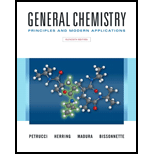
(a)
Interpretation:
The given radioactive process needs to be explained.
Concept introduction:
The emission of
- (a)Alpha decay
(b) Beta decay
(c) Gamma decay
Answer to Problem 1E
Explanation of Solution
In
Atomic number is equal to number of protons or number of electrons. Also, mass number is sum of number of protons and neutrons.
In beta decay, the number of electrons decreases thus, atomic number decreases to 25 but mass number remains the same.
(b)
Interpretation:
The given radioactive process needs to be explained.
Alpha decay of
Concept introduction:
The emission of electromagnetic radiation or particles from nucleus takes place in radioactive processes. The common radiations from emitted by nucleus are as follows:
- (a)Alpha decay
(b)Beta decay
(c)Gamma decay
Answer to Problem 1E
Explanation of Solution
In
Atomic number is equal to number of protons or number of electrons. Also, mass number is sum of number of protons and neutrons.
In alpha decay, the atomic number gets decreases by 2 unit and mass number decreases by 4 units thus, the new nucleus formed will have 234 as mass number and 90 as atomic number.
The element corresponding to atomic number 90 is thorium.
The nuclear reaction can be represented as follows:
(c)
Interpretation:
The given radioactive process needs to be explained.
Two successive alpha decay of
Concept introduction:
The emission of electromagnetic radiation or particles from nucleus takes place in radioactive processes. The common radiations emitted by nucleus are as follows:
- (a) Alpha decay
(b) Beta decay
(c)Gamma decay
Answer to Problem 1E
Explanation of Solution
In
Atomic number is equal to number of protons or number of electrons. Also, mass number is the total sum of both protons and neutrons.
In alpha decay, the atomic number gets decreases by 2 unit and mass number decreases by 4 units. In first alpha decay, the new nucleus formed will have 218 as mass number and 84 as atomic number.
The element corresponding to atomic number 84 is polonium.
The nuclear reaction can be represented as follows:
After second alpha decay, the new nucleus formed will have 214 as mass number and 82 as atomic number.
The element corresponding to atomic number 82 is lead.
The nuclear reaction can be represented as follows:
Thus, the nuclear reaction representing two successive alpha decays is as follows:
(d)
Interpretation:
The given radioactive process needs to be explained.
Two successive
Concept introduction:
The emission of electromagnetic radiation or particles from nucleus takes place in radioactive processes. The common radiations from emitted by nucleus are as follows:
- (a) Alpha decay
(b) Beta decay
(c) Gamma decay
Answer to Problem 1E
Explanation of Solution
In
Atomic number is equal to number of protons or number of electrons. Also, mass number is sum of number of protons and neutrons.
In beta decay, the number of electrons decreases and mass number remains the same.
In first beta decay, the new nucleus formed will have 64 as mass number and 28 as atomic number.
The element corresponding to atomic number 28 is nickel.
The nuclear reaction can be represented as follows:
After second beta decay, the new nucleus formed will have 64 as mass number and 27 as atomic number.
The element corresponding to atomic number 27 is cobalt.
The nuclear reaction can be represented as follows:
Thus, the nuclear reaction representing two successive beta decays is as follows:
Want to see more full solutions like this?
Chapter 25 Solutions
GENERAL CHEMISTRY-MOD.MASTERINGCHEM.
- Please help me with number 1-3. Thank you so much.arrow_forwardDraw the major product of this reaction ingnore the inorganic byproducts. 1. NaOCH2CH3 at 25 C 2. PhCH2Br (1 eq)arrow_forwardAt 90ºC the vapor pressure of ortho-xylene is 20 kPa and that of meta-xylene is 18 kPa. What is the composition of the vapor in equilibrium with a mixture in which the mole fraction of o-xylene is 0.60?arrow_forward
- Draw the products of this reduction of a ketone with sodium borohydride. Use a dash or wedge bond to indicate the stereochemistry of substituents on asymmetric centers, where applicableIgnore any inorganic byproducts. 1) NaBH4 2) HCI/H2O Select to Drawarrow_forwardWhy do you think people who live at high altitudes are advised to add salt to water when boiling food like pasta? What mole fraction of NaCl is needed to raise the boiling point of H2O by 3˚C? Does the amount of salt added to water (typically about one teaspoon to four quarts of water) substantially change the boiling point? (Kb (H2O) = 0.51˚C/molal.)arrow_forwardpls help asaparrow_forward
- pls help asaparrow_forward9. Consider the following galvanic cell: Fe (s) | Fe(NO3)2 (aq) || Sn(NO3)2 (aq) | Sn (s) a. Write an equation for the half reactions occurring at the anode and cathode. b. Calculate the standard cell potential Show all of your work. c. Draw and label the galvanic cell, including the anode and cathode, direction of electron flow, and direction of ion migration.arrow_forwardpls help asaparrow_forward
- 11. Use the equation below to answer the following questions: 2 Al(s) + 3 Cd(NO3)2 (aq) → 2 Al(NO3)3 (aq) + 3 Cd(s) a. What is the net ionic equation for the reaction? b. Which species is a spectator ion in this reaction? Define a spectator ion. c. Identify the oxidizing agent and the reducing agent.arrow_forwardpls help asaparrow_forwardpls help asaparrow_forward
 ChemistryChemistryISBN:9781305957404Author:Steven S. Zumdahl, Susan A. Zumdahl, Donald J. DeCostePublisher:Cengage Learning
ChemistryChemistryISBN:9781305957404Author:Steven S. Zumdahl, Susan A. Zumdahl, Donald J. DeCostePublisher:Cengage Learning Chemistry: An Atoms First ApproachChemistryISBN:9781305079243Author:Steven S. Zumdahl, Susan A. ZumdahlPublisher:Cengage Learning
Chemistry: An Atoms First ApproachChemistryISBN:9781305079243Author:Steven S. Zumdahl, Susan A. ZumdahlPublisher:Cengage Learning
 Chemistry for Engineering StudentsChemistryISBN:9781337398909Author:Lawrence S. Brown, Tom HolmePublisher:Cengage Learning
Chemistry for Engineering StudentsChemistryISBN:9781337398909Author:Lawrence S. Brown, Tom HolmePublisher:Cengage Learning Chemistry by OpenStax (2015-05-04)ChemistryISBN:9781938168390Author:Klaus Theopold, Richard H Langley, Paul Flowers, William R. Robinson, Mark BlaserPublisher:OpenStax
Chemistry by OpenStax (2015-05-04)ChemistryISBN:9781938168390Author:Klaus Theopold, Richard H Langley, Paul Flowers, William R. Robinson, Mark BlaserPublisher:OpenStax





